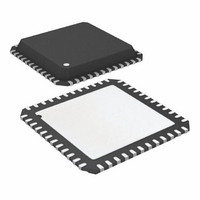ATA6603P-PLQW Atmel, ATA6603P-PLQW Datasheet - Page 96

ATA6603P-PLQW
Manufacturer Part Number
ATA6603P-PLQW
Description
MCU W/LIN TXRX REG WTCHDG 48-QFN
Manufacturer
Atmel
Series
AVR® ATA66 LIN-SBCr
Datasheet
1.ATA6603P-PLQW.pdf
(360 pages)
Specifications of ATA6603P-PLQW
Core Processor
AVR
Core Size
8-Bit
Speed
16MHz
Connectivity
I²C, LIN, SPI, UART/USART
Peripherals
Brown-out Detect/Reset, POR, PWM, WDT
Number Of I /o
23
Program Memory Size
16KB (16K x 8)
Program Memory Type
FLASH
Eeprom Size
512 x 8
Ram Size
1K x 8
Voltage - Supply (vcc/vdd)
2.7 V ~ 5.5 V
Data Converters
A/D 8x10b
Oscillator Type
Internal
Operating Temperature
-40°C ~ 125°C
Package / Case
48-QFN Exposed Pad
Lead Free Status / RoHS Status
Lead free / RoHS Compliant
Available stocks
Company
Part Number
Manufacturer
Quantity
Price
Company:
Part Number:
ATA6603P-PLQW
Manufacturer:
ATMEL
Quantity:
2 000
Part Number:
ATA6603P-PLQW
Manufacturer:
ATMEL/爱特梅尔
Quantity:
20 000
- Current page: 96 of 360
- Download datasheet (6Mb)
96
ATA6602/ATA6603
The alternate pin configuration is as follows:
• XTAL2/TOSC2/PCINT7 – Port B, Bit 7
• XTAL1/TOSC1/PCINT6 – Port B, Bit 6
• SCK/PCINT5 – Port B, Bit 5
• MISO/PCINT4 – Port B, Bit 4
XTAL2: Chip clock Oscillator pin 2. Used as clock pin for crystal Oscillator or Low-frequency
crystal Oscillator. When used as a clock pin, the pin can not be used as an I/O pin.
TOSC2: Timer Oscillator pin 2. Used only if internal calibrated RC Oscillator is selected as
chip clock source, and the asynchronous timer is enabled by the correct setting in ASSR.
When the AS2 bit in ASSR is set (one) and the EXCLK bit is cleared (zero) to enable asyn-
chronous clocking of Timer/Counter2 using the Crystal Oscillator, pin PB7 is disconnected
from the port, and becomes the inverting output of the Oscillator amplifier. In this mode, a
crystal Oscillator is connected to this pin, and the pin cannot be used as an I/O pin.
PCINT7: Pin Change Interrupt source 7. The PB7 pin can serve as an external interrupt
source.
If PB7 is used as a clock pin, DDB7, PORTB7 and PINB7 will all read 0.
XTAL1: Chip clock Oscillator pin 1. Used for all chip clock sources except internal calibrated
RC Oscillator. When used as a clock pin, the pin can not be used as an I/O pin.
TOSC1: Timer Oscillator pin 1. Used only if internal calibrated RC Oscillator is selected as
chip clock source, and the asynchronous timer is enabled by the correct setting in ASSR.
When the AS2 bit in ASSR is set (one) to enable asynchronous clocking of Timer/Counter2,
pin PB6 is disconnected from the port, and becomes the input of the inverting Oscillator
amplifier. In this mode, a crystal Oscillator is connected to this pin, and the pin can not be
used as an I/O pin.
PCINT6: Pin Change Interrupt source 6. The PB6 pin can serve as an external interrupt
source.
If PB6 is used as a clock pin, DDB6, PORTB6 and PINB6 will all read 0.
SCK: Master Clock output, Slave Clock input pin for SPI channel. When the SPI is enabled
as a Slave, this pin is configured as an input regardless of the setting of DDB5. When the
SPI is enabled as a Master, the data direction of this pin is controlled by DDB5. When the
pin is forced by the SPI to be an input, the pull-up can still be controlled by the PORTB5 bit.
PCINT5: Pin Change Interrupt source 5. The PB5 pin can serve as an external interrupt
source.
MISO: Master Data input, Slave Data output pin for SPI channel. When the SPI is enabled
as a Master, this pin is configured as an input regardless of the setting of DDB4. When the
SPI is enabled as a Slave, the data direction of this pin is controlled by DDB4. When the pin
is forced by the SPI to be an input, the pull-up can still be controlled by the PORTB4 bit.
PCINT4: Pin Change Interrupt source 4. The PB4 pin can serve as an external interrupt
source.
4921E–AUTO–09/09
Related parts for ATA6603P-PLQW
Image
Part Number
Description
Manufacturer
Datasheet
Request
R

Part Number:
Description:
MCU, MPU & DSP Development Tools Demoboard LIN-MCM
Manufacturer:
Atmel
Datasheet:

Part Number:
Description:
Microcontroller With Lin Transceiver, 5v Regulator And Watchdog
Manufacturer:
ATMEL Corporation
Datasheet:

Part Number:
Description:
DEV KIT FOR AVR/AVR32
Manufacturer:
Atmel
Datasheet:

Part Number:
Description:
INTERVAL AND WIPE/WASH WIPER CONTROL IC WITH DELAY
Manufacturer:
ATMEL Corporation
Datasheet:

Part Number:
Description:
Low-Voltage Voice-Switched IC for Hands-Free Operation
Manufacturer:
ATMEL Corporation
Datasheet:

Part Number:
Description:
MONOLITHIC INTEGRATED FEATUREPHONE CIRCUIT
Manufacturer:
ATMEL Corporation
Datasheet:

Part Number:
Description:
AM-FM Receiver IC U4255BM-M
Manufacturer:
ATMEL Corporation
Datasheet:

Part Number:
Description:
Monolithic Integrated Feature Phone Circuit
Manufacturer:
ATMEL Corporation
Datasheet:

Part Number:
Description:
Multistandard Video-IF and Quasi Parallel Sound Processing
Manufacturer:
ATMEL Corporation
Datasheet:

Part Number:
Description:
High-performance EE PLD
Manufacturer:
ATMEL Corporation
Datasheet:

Part Number:
Description:
8-bit Flash Microcontroller
Manufacturer:
ATMEL Corporation
Datasheet:

Part Number:
Description:
2-Wire Serial EEPROM
Manufacturer:
ATMEL Corporation
Datasheet:











